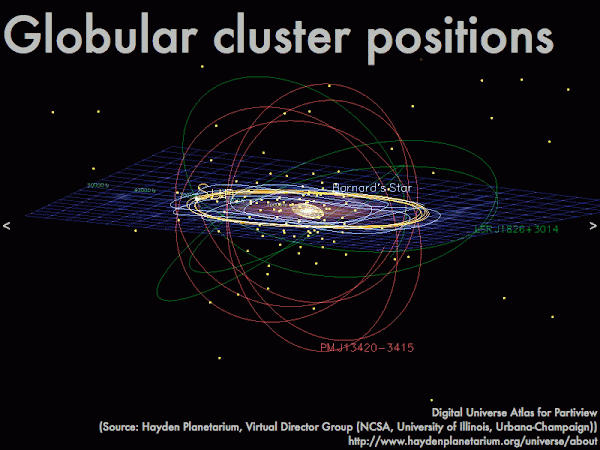
 This presentation will discuss the shape, size, and composition of our galaxy, the Milky Way. Two subsequent presentations will expand upon the spiral arms and past history of the Milky Way.
This presentation will discuss the shape, size, and composition of our galaxy, the Milky Way. Two subsequent presentations will expand upon the spiral arms and past history of the Milky Way. Previously you were asked in the online reading assignment how you would determine whether or not you were having a bad hair day if you were camping, and did not bring along a mirror. Because you just happen to be a high-maintenance camper, and what your hair looks like is important to you. (So, what are some of your ideas on solving the high-maintenance camper's dilemma?)
Previously you were asked in the online reading assignment how you would determine whether or not you were having a bad hair day if you were camping, and did not bring along a mirror. Because you just happen to be a high-maintenance camper, and what your hair looks like is important to you. (So, what are some of your ideas on solving the high-maintenance camper's dilemma?) And yes, it turns out that we are all high-maintenance campers, very much concerned with what our hair happens to look like. We don't have a mirror or a friend to tell us whether or not we're a galaxy with spiral arms (and thus having a good hair day), or maybe an unremarkable blob-shaped galaxy (and this having a bad hair day). This is important to us! But like some of your creative, indirect methods on how to solve the high-maintenance camper's dilemma, there are creative, indirect methods on how to find out what kind of galaxy the Milky Way is.
And yes, it turns out that we are all high-maintenance campers, very much concerned with what our hair happens to look like. We don't have a mirror or a friend to tell us whether or not we're a galaxy with spiral arms (and thus having a good hair day), or maybe an unremarkable blob-shaped galaxy (and this having a bad hair day). This is important to us! But like some of your creative, indirect methods on how to solve the high-maintenance camper's dilemma, there are creative, indirect methods on how to find out what kind of galaxy the Milky Way is. First, what shape does the Milky Way have?
First, what shape does the Milky Way have? At a very dark sky location, take a look at the Milky Way, which to the ancient Greeks resembled a milky stream across the sky. Because the sky is not filled with the stars in our galaxy in every direction, but only a stream across the sky, we can resolve the high-maintenance camper dilemma with the naked eye. (Video link: "A Night At Paranal: From Milky Way Set To Moonrise.")
At a very dark sky location, take a look at the Milky Way, which to the ancient Greeks resembled a milky stream across the sky. Because the sky is not filled with the stars in our galaxy in every direction, but only a stream across the sky, we can resolve the high-maintenance camper dilemma with the naked eye. (Video link: "A Night At Paranal: From Milky Way Set To Moonrise.") Seeing many stars in a strip around us, but very few stars in the directions perpendicular to this strip tells us so far that we live in a flattened disk-shaped galaxy, as in this art installation, where most of the lights are distributed at eye level in this mirrored room, while very few are above or below eye level.
Seeing many stars in a strip around us, but very few stars in the directions perpendicular to this strip tells us so far that we live in a flattened disk-shaped galaxy, as in this art installation, where most of the lights are distributed at eye level in this mirrored room, while very few are above or below eye level. Second, how large is the Milky Way, and where are we located in it?
Second, how large is the Milky Way, and where are we located in it? Because of the interstellar medium of gas and dust between stars, we can only see a portion of a presumably larger Milky Way disk. But since we have relatively clear views above and below the plane of the disk, we can look for certain landmarks to tell us how far away we are from the center of the Milky Way. This is like not being able to see very far into a fog bank, but by looking at tall structures that poke up above the fog, we can deduce where downtown is located.
Because of the interstellar medium of gas and dust between stars, we can only see a portion of a presumably larger Milky Way disk. But since we have relatively clear views above and below the plane of the disk, we can look for certain landmarks to tell us how far away we are from the center of the Milky Way. This is like not being able to see very far into a fog bank, but by looking at tall structures that poke up above the fog, we can deduce where downtown is located.  Like tall buildings and bridges that poke up above the fog and give us clues to how far away we are from downtown, we will direct our attention to globular clusters, which are giant groups of stars found above and below the disk of the Milky Way. If we find many of these globular clusters equally spread out in all directions around us, then we must lie at (or near) the center of the Milky Way. Or if we find many globular clusters bunched up some distance from us, then that must be the location of the Milky Way center.
Like tall buildings and bridges that poke up above the fog and give us clues to how far away we are from downtown, we will direct our attention to globular clusters, which are giant groups of stars found above and below the disk of the Milky Way. If we find many of these globular clusters equally spread out in all directions around us, then we must lie at (or near) the center of the Milky Way. Or if we find many globular clusters bunched up some distance from us, then that must be the location of the Milky Way center.

 So far we have evidence that gives us an idea of the shape and size of the Milky Way. Third, what is the composition of the Milky Way?
So far we have evidence that gives us an idea of the shape and size of the Milky Way. Third, what is the composition of the Milky Way? Any of you avid Futurama fans? What was the deal with "dark matter" on that TV show? However, dark matter in astronomy is neither Nibblonian poop or spaceship fuel, but what the Milky Way is primarily made of, as opposed to "light" matter (objects that emit/absorb/reflect/interact with light--stars, planets, gas, dust, etc.). Let's investigate the evidence for dark matter composition of the Milky Way.
Any of you avid Futurama fans? What was the deal with "dark matter" on that TV show? However, dark matter in astronomy is neither Nibblonian poop or spaceship fuel, but what the Milky Way is primarily made of, as opposed to "light" matter (objects that emit/absorb/reflect/interact with light--stars, planets, gas, dust, etc.). Let's investigate the evidence for dark matter composition of the Milky Way.
On the right, the inner orbits have the same speed as the outer orbits. This is what is observed in other galaxies as well as our Milky Way, and immediately this tells us most of the mass in galaxies is typically not concentrated at the center. In order for the outer orbits have the same speed as the inner orbits, the outer orbits must experience the same amount of gravity as the inner orbits.
This means that the gravity in the galaxy on the right is "smeared out" everywhere, instead of being concentrated at the center. Measurements of the mass required to create this uniform distribution of gravity cannot be accounted for by the stars--there aren't enough stars to do that! Neither is there enough gas or dust to create this uniform distribution of gravity. But there must something creating this much gravity everywhere in a galaxy--something that does not give off light (like a star), nor absorbing or reflecting light (like gas and dust). Since we know how much matter must be present (because of the gravity required to make outer orbits travel with the same speed as inner orbits), yet cannot detect with light, it has been (provisionally) named "dark matter."

- MACHOs--MAssive Compact Halo Objects, maybe dim red dwarfs and black holes and other modest-sized objects floating out in the halo; or,
- WIMPs--Weakly Interacting Massive Particles, proposed particles with a substantive amount of mass that do not (or only weakly) interact with light, floating around and passing between and through everything else in the galaxy.
 ...which brings up an interesting point--even though we're not entirely certain what dark matter may be made of, it doesn't mean that dark matter doesn't exist--the documented, detailed effect on the orbital motions of stars and globular clusters in our Milky Way and other galaxies is very real. Like a suspect in a crime, even though it may never be definitively solved, doesn't mean that this person doesn't exist--the documented, detailed evidence of this person's impact on his victims and society is very real...
...which brings up an interesting point--even though we're not entirely certain what dark matter may be made of, it doesn't mean that dark matter doesn't exist--the documented, detailed effect on the orbital motions of stars and globular clusters in our Milky Way and other galaxies is very real. Like a suspect in a crime, even though it may never be definitively solved, doesn't mean that this person doesn't exist--the documented, detailed evidence of this person's impact on his victims and society is very real...
No comments:
Post a Comment